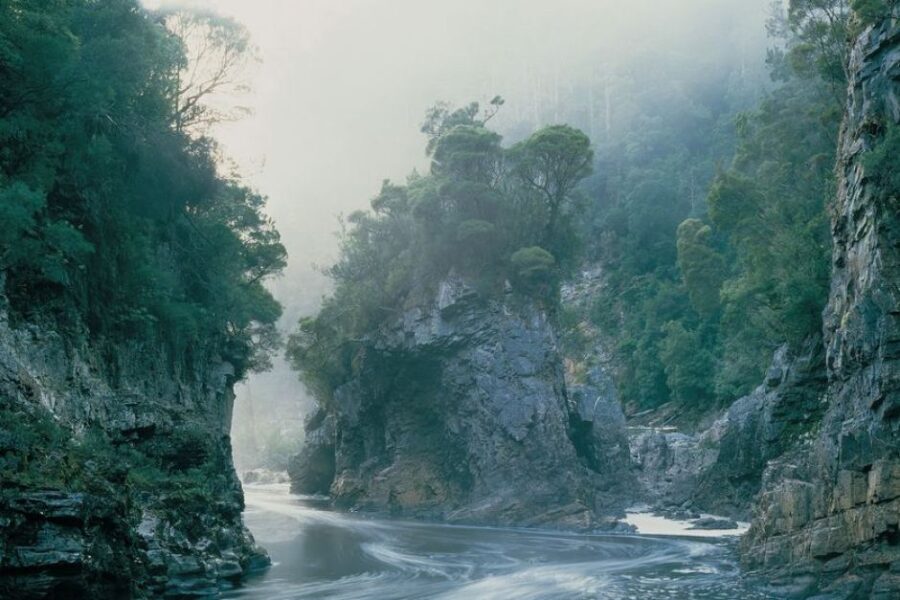>> 1978; the Tasmanian Hydro Electric Commission (HEC) announce their intention to harness the Franklin River for hydroelectricity, proposing two dam sites, the Gordon below Franklin Dam (105m high) a few km below the Franklin Gordon confluence and Dam #2 at the end of the Mount McCall Track.
>> one of most significant successful environmental campaigns in Australian history, led by The Wilderness Society under Bob Brown starts
>> June 1980; an estimated 10,000 no-dams people march the streets of Hobart
>> the Labor state government, under premier Doug Lowe, agrees to place the Franklin River in a new “Wild Rivers National Park”. Instead of the original ‘Gordon below Franklin’ proposal, Lowe now backs the ‘Gordon above Olga’ scheme.
>> 1981, Senate inquiry into “the natural values of south-west Tasmania to Australia and the world” and “the federal responsibility in assisting Tasmania to preserve its wilderness areas of national and international importance” is initiated by Australian Democrats Senator Don Chipp
>> early 1981 Kevin Kiernan discovers Aboriginal caves on the Lower Franklin, containing Aboriginal hand stencils as well as remnants of campfires and stone tools between 8,000 and 24,000 years old. Concerns begin to be raised about habitat loss for endangered species.
>> 12 Dec 1981; In the Power Referendum 1981 around 47% of Tasmanians vote for the original Gordon below Franklin scheme, about 8% for the Gordon above Olga scheme, and 45% vote informally with more than 33% of voters writing “No Dams” on their ballot papers.
>> 15 May 1982 in the state election Harry Holgate, who had replaced Doug Lowe as Premier in 1981, is defeated by Robin Gray’s Liberal government. Dam building continues and the necessary legislation gets passed. For Robin Gray the Franklin River is ‘nothing but a brown ditch, leech-ridden and unattractive to the majority of people’.
>> Federal Government under Malcolm Fraser offers the Gray government $500 million to stop the Franklin dam. Gray refuses the offer and Fraser declines any further action, claiming the dam was a state matter.
>> During 1982 the anti-dam campaigns are ramping up with people like Bob Brown, David Bellamy and Dick Smith speaking out nationally. The iconic “No Dams” triangle sticker is printed.

>> 14 December 1982; the Democrats’ World Heritage Protection Bill passes the Australian Senate, giving the Governor General the power to issue proclamations for particular places.
>> 14 December 1982; the World Heritage Commission accepts the nomination of the South West for heritage listing
>> 14 December 1982; start of the blockade of the dam site at “Warners Landing” on the Gordon River, drawing an estimated 2,500 people from Tasmania, interstate and overseas.
>> January 1983; around fifty people arrive at the blockade each day. The state government makes things difficult for the protesters, passing several laws and enforcing special bail conditions for those arrested. Bulldozers arrive at the dam site. A total of 1,217 arrests are made, including David Bellamy, Claudio Alcorso, Andrew Lohrey, and Bob Brown, many simply for being present at the blockade.
>> February 1983; approximately 20,000 people attend a Hobart rally against the dam.
>> 1 March 1983; “G-Day” a day of anti-dam action, 231 people are arrested as a flotilla of boats takes to the Gordon River. In Hobart, the Wilderness Society flag is flown above the HEC building.
>> 2 March 1983; publication of an iconic photograph, Morning Mist, Rock Island Bend, Franklin River by Peter Dombrovskis accompanied by the caption “Could you vote for a party that would destroy this?” backed by The Wilderness Society

>> 5 March 1983, the Australian Labor Party under Bob Hawke wins the federal election. Hawke’s government first passes regulations under the existing National Parks and Wildlife Conservation Act 1975, and then passes the World Heritage Properties Conservation Act 1983, which prohibits Franklin River dam-related clearing, excavation and building activities that had been authorised by Tasmanian state legislation.
>> The Tasmanian government ignores both the federal regulations and legislation and HEC continues to work on the dam.
>> 31 May 1983 The issue is brought before the High Court, Commonwealth v Tasmania. The government of Tasmania claims that as the right to legislate for the environment was not named in the Constitution, and was thus a residual power held by the states, that the World Heritage Properties Conservation Act 1983 was unconstitutional. The federal government, however, claimed that they had the right to do so, under the ‘external affairs’ provision of the Constitution as, by passing legislation blocking the dam’s construction, they were fulfilling their responsibilities under an international treaty (the UNESCO Convention for the Protection of the World Cultural and Natural Heritage, Australia having signed and ratified that convention and the Franklin River having been listed on it). The Commonwealth government also argued that the federal legislation was supported by the constitutional powers of a federal government to pass laws about corporations and about the people of any race (in this case the aboriginal race, whose sacred caves along the Franklin would have been inundated).
>> 1 July 1983, in a landmark decision, the High Court on circuit in Brisbane rules in the federal government’s favour by a vote of 4 (Judges Mason, Murphy, Brennan and Deane) to 3 (justices Wilson and Dawson with Chief Justice Gibbs). This ruling gave the federal government the power to legislate on any issue if necessary to enforce an international treaty and has been the subject of controversy ever since.
>> the High Court ruling finally ends the Franklin dam’s construction. The Franklin River can continue to run free!
Read more about the Franklin River Campaign, the Wilderness Society

